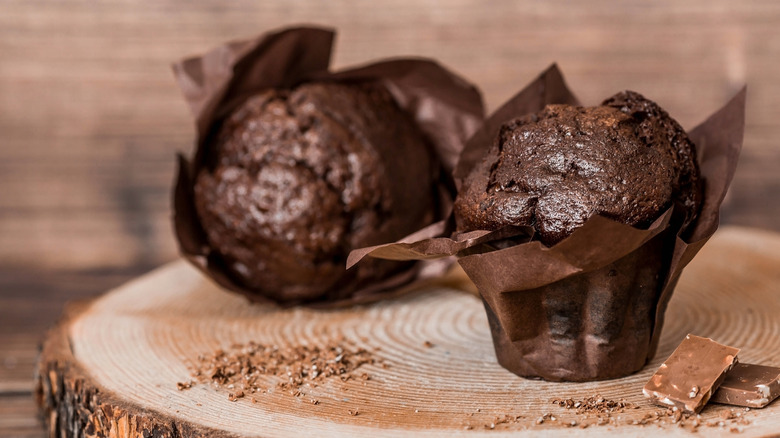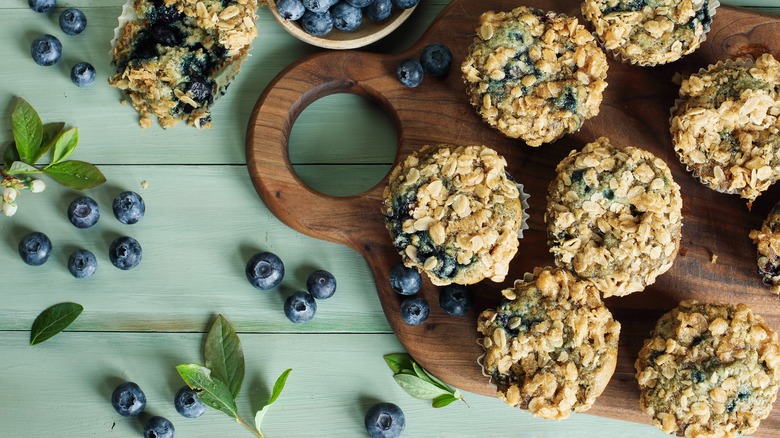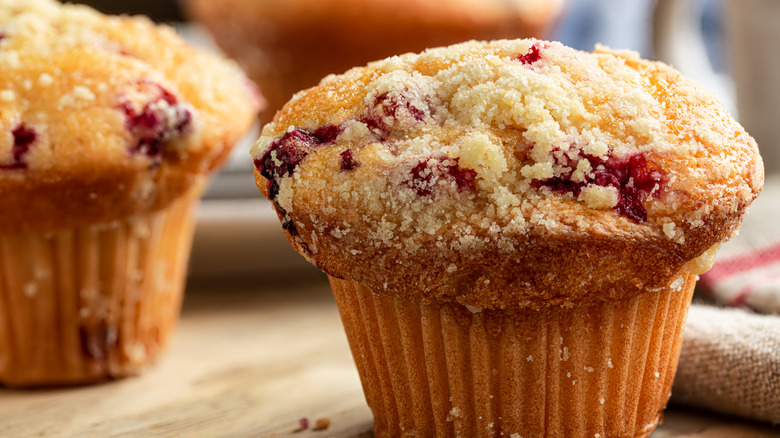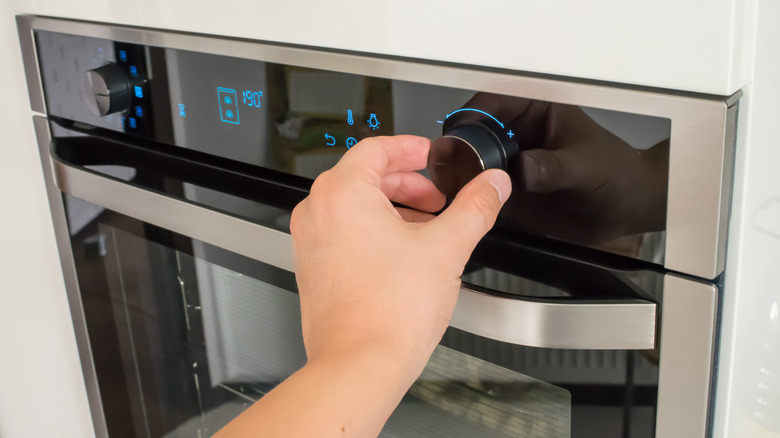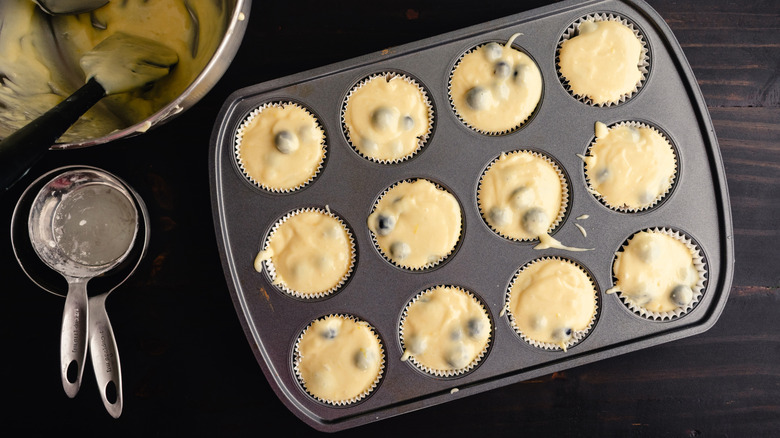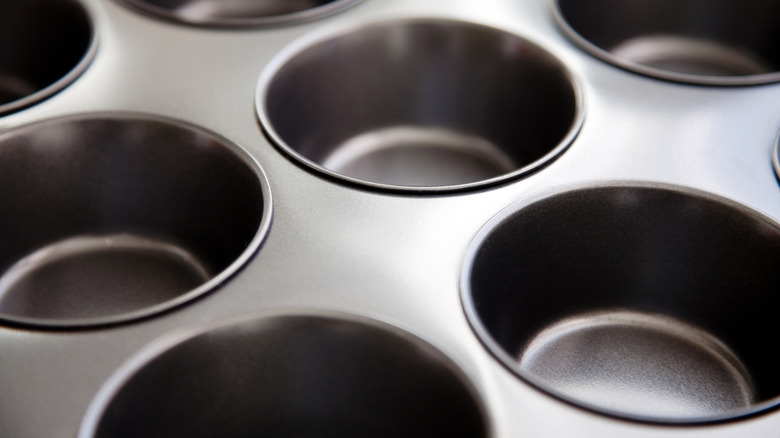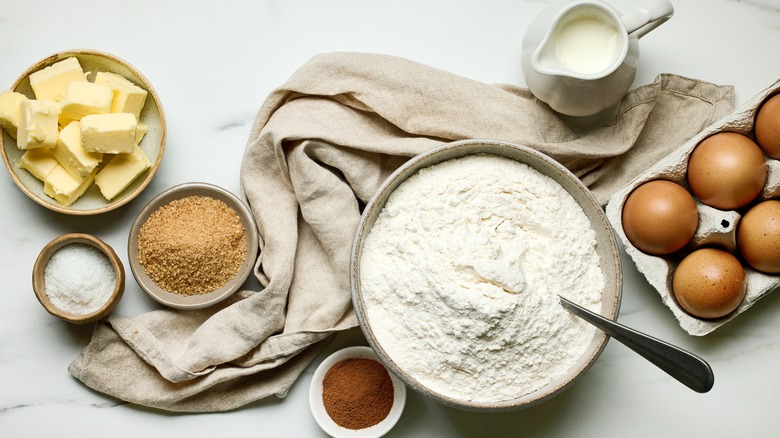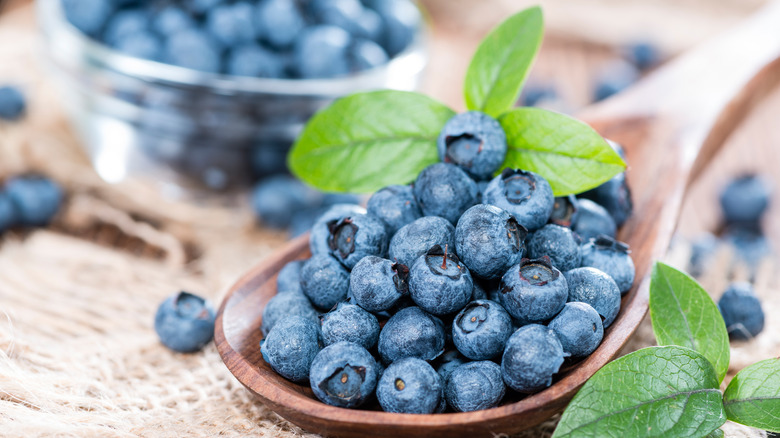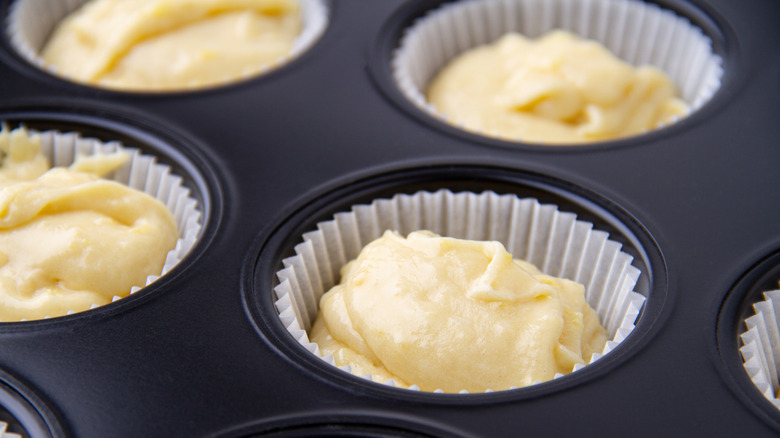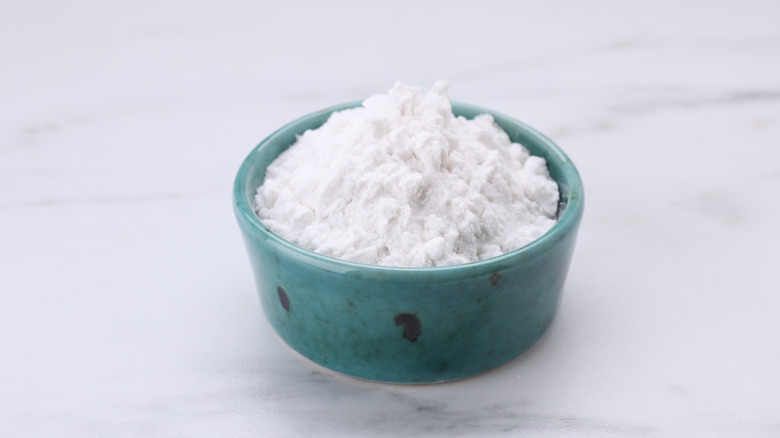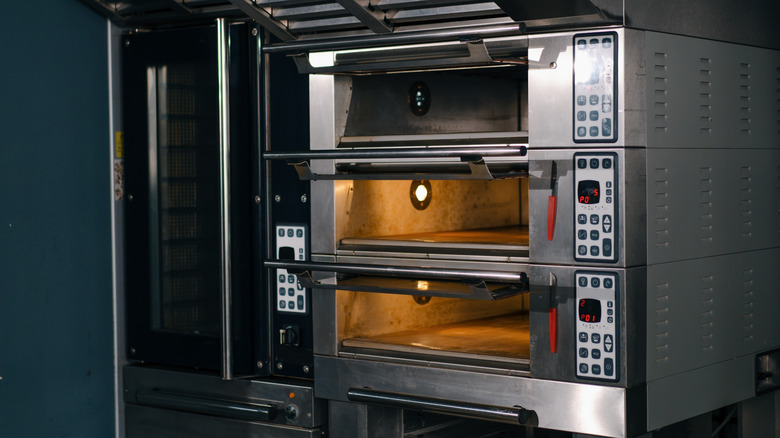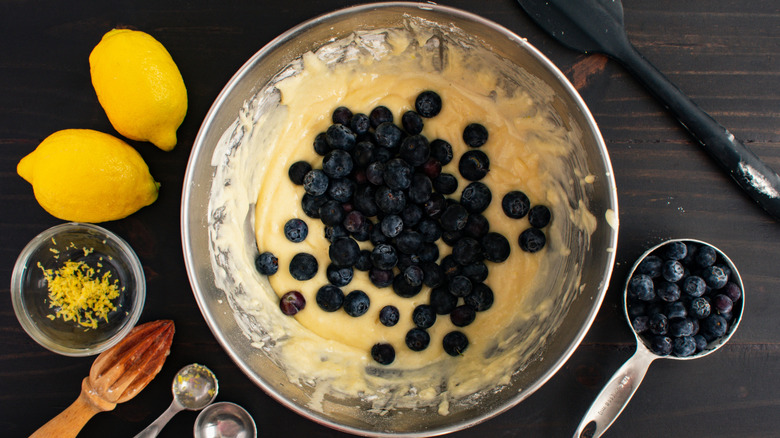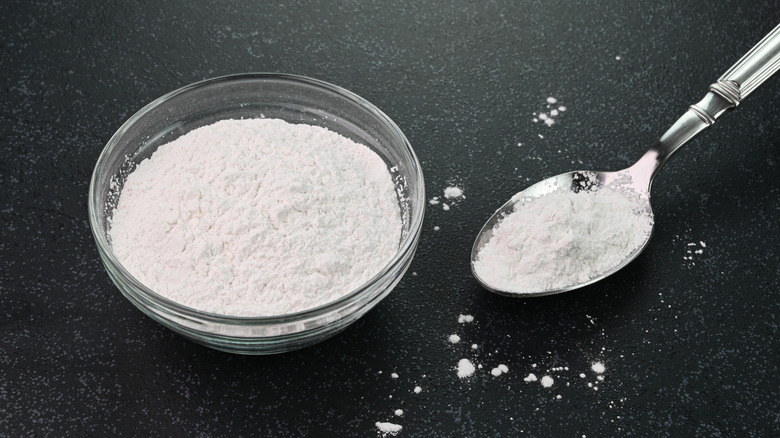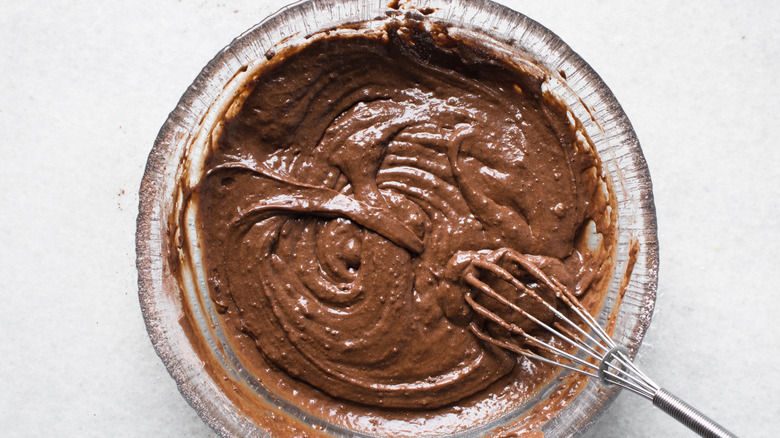Why Muffins Are Always Better From A Bakery
Bakery muffins are a work of art. Tall, with huge domed tops and a soft, airy crumb. But when you try to make them yourself at home, they're never quite the same. This can leave you wondering why muffins are always better from a bakery. And if you think you might have better luck buying them from a store than attempting them yourself, you're probably wrong. Store-bought muffins are usually lackluster and can be packed with artificial ingredients.
So, what are the secrets bakeries don't want to let us in on? The size and height make a huge difference— and there are several bakery-approved techniques to achieve this at home. Bakeries also have ways of getting the perfect texture, such as mixing the batter perfectly and using steam in the oven. Then, there's the flavor. Yes, bakery muffins taste amazing but you can absolutely get the same great flavor at home if you use good ingredients.
We all know that muffins from bakeries are top tier but we're about to tell you why. There isn't a single reason but rather a collection of factors that help level them up. Once you know what's up, you'll be able to make better muffins at home. Though, we'd understand if you just want to head to your favorite bakery instead.
Bakeries know how to level-up their streusel topping
Professional bakers don't just think about the ingredients inside the muffin batter, they consider toppings as well. And while not every bakery muffin has a streusel topping, it's a fairly common feature. A sprinkling of streusel can transform muffins from just fine to exceptional, but bakeries know how to level theirs up to make them even more delicious.
First, what exactly is a streusel topping? At its most simple, it's a mixture of butter, flour, and sugar that's rubbed together to form a breadcrumb like texture. It's the same mixture that's on a crumb cake or the top of an apple crisp. Bakeries might choose to mix in a little cinnamon or other sweet spices, like nutmeg or cardamom, to give it some extra flavor. Sometimes they replace some of the sugar in the streusel with vanilla sugar.
When baked, the streusel topping turns crunchy, which is a pleasing contrast to a pillowy soft, moist muffin. But this is especially obvious when bakery muffins have special extras in their streusel, such as chopped nuts or pearl sugar. These additions boost flavor and give more crunchy texture to take baked goods up a level. It might seem like a simple addition, but these small touches can all add up to something special. What's great is that it's easy enough to doctor streusel if you want to level-up your homemade offerings.
There may be more baking powder in bakery muffins
Let's not pretend that size doesn't matter in the world of muffins. Bigger is definitely better and the ones you get from a bakery are almost always larger than homemade versions with more impressive domes. One of the ways bakeries achieve this is by adding extra baking powder. Muffins in bakeries are made in such large batches that it can be hard to scale them down precisely. However, those looking to make bakery-style muffins sometimes use around 4 teaspoons of baking powder per average batch. There may also be a combination of baking powder and baking soda.
While adding some extra raising agent to the batter helps, using too much can be a hindrance. This will make them rise taller at first, but baking powder and baking soda can only do so much. When you add too much raising agent to muffins, they can rise quickly but ultimately sink or fall apart. Excessive baking powder or soda in a recipe can also cause a bitter taste.
Another way to get bigger muffins is to use a jumbo muffin pan. These have cups that are bigger than average, so your muffins will always come out larger. They hold roughly twice as much batter as regular muffin tins, so you can use a standard recipe, but expect to make six muffins rather than 12. Just remember to adjust the baking time — larger muffins take longer to cook; usually around 25 to 30 minutes.
Professional bakers carefully control the heat for the ultimate rise
Professional bakers know that the temperature you bake your muffins at makes a difference. They have professional quality ovens, the most high-tech of which can be programmed to raise and lower their temperature during the cooking process. However, with a little effort, you can achieve the same results at home just by manually adjusting your oven.
You can get taller muffins by giving them an initial blast of heat when you first put them in the oven. This kickstarts the raising agents in the batter and produces more steam, contributing to tall, domed muffins with a light, fluffy texture. The trouble is, cooking them at a high temperature all the way through can cause them to burn on the outside before they're cooked through. So, you want to start at a high oven temperature and then turn it down.
For regular sized muffins, start with an initial five minutes in an oven preheated to 425 degrees Fahrenheit. Then, turn the oven down to 350 degrees Fahrenheit and bake for a further 15 minutes. This should give you perfectly cooked muffins, though it's always a good idea to check with a skewer or toothpick to make sure they're done in the middle.
Professional bakers fill muffin cups more than most recipes recommend
You might have had it drummed into you to fill the cups of your muffin pan no more than ½ to ⅔ full. This gives your batter room to expand without spilling over the edges of the cup. However, professional bakers often fill the cups right the way to the brim. If you're aiming for muffins with huge domed tops, this is the way to go.
When you fill the holes in muffin pans well below the top, this gives them room to rise while still staying roughly muffin cup sized. This is great when you want a more compact muffin as an everyday treat, but when you want a bakery-style beast it just won't cut it. While there are other factors that impact the height of your finished bakes, they can only go so far. Sometimes you just need more batter to get a bigger muffin.
You have to forget everything you learned about baking and it might still feel weird to fill your cups up so full. But stick with it and you'll get bakery-style results every time. Bear this in mind, though — it will produce fewer muffins if you stick to a standard recipe. When you want to make a full dozen, you may need to increase the recipe by half or even double it to be on the safe side.
Bakeries often only fill every other muffin cup
So, you take the advice above and fill your muffin cups right up to the top. This gives you those amazing mushroom shaped domes that you'll find on the best bakery muffins. This is great in practice, but in reality, those domes run into each other and you're left with one giant interconnected muffin top. How do bakeries deal with that problem? Well, we'll let you in on a secret. Bakeries that make muffins with big mushroomy tops only use every other hole in the muffin pan.
Think about it, it's really the only way to get that kind of muffin top. It needs space around it to expand, so it doesn't run into its neighbors. So, bakeries make sure to never fill two consecutive cups. This means, in the first row of three, the left and right cups are filled and the middle empty, then only the middle cup is filled on the next row, and so on. Sure, you can only fit six muffins in one pan this way, but the results are worth it.
When you're making this style of muffin, you have to remember to grease the top of the muffin pan around each filled cup, as well as greasing the cups themselves (unless you're using muffin liners). Part of the dome sits directly on the top of the pan and cooks there, which is how you get that dramatic shape that comes out before doming.
Muffins from a bakery are made with fresh, high-quality ingredients
Part of the reason why bakery muffins are so much better than store-bought ones is that they're made with fresh, high quality ingredients. Those bought from a store often have long ingredient lists filled with names you don't recognize. Not to mention that you should avoid buying blueberry-flavored products — including blueberry muffins — because they often contain fake blueberries. These are little blue nuggets of sugar masquerading as the real deal.
But bakeries can even have homemade muffins beat in terms of ingredient quality. A good professional baker will think carefully about what they put in their products and how that affects the finished item. Bakeries usually use very fresh, quality eggs and dairy products in their muffins and may use butter for flavor, rather than oil or vegetable shortening. It's likely that professionals will also think about the type of flour used and its properties, such as protein content and whether it's bleached or unbleached. All of this can make a big difference to quality, which is why it can be tough to make baked goods at home that are as good as those from bakeries.
Some bakeries mash blueberries for their muffins
If you've ever heard of Jordan Marsh blueberry muffins, you might know that they were touted as some of the best around. Originally made by the Jordan Marsh department store in Boston, they're known for their towering tops and tender crumb. But a big part of what set them apart is that they mashed some of the blueberries into the batter. While it started with Jordan Marsh, this is a technique that some bakeries use to increase that intense blueberry flavor.
If you want to try this out, mash about half the blueberries called for in the recipe and leave the others whole. This adds more liquid to the recipe to make it even more moist and lighter. It also helps to distribute the berry flavor more evenly through the mixture. Usually, you get a hit of blueberry when you bite into a whole one but the sponge part of the muffin largely tastes of vanilla. But when bakeries use the mashing technique, there's a blueberry flavor throughout the whole bake. What's more, it's an extremely simple adjustment. It only takes a few minutes to mash berries but it can make a big difference to the outcome.
Bakery muffins are made with a thick, scoopable batter
You might think of muffin batter having a relatively thin, pourable consistency. This is true of many recipes, so the idea didn't come from nowhere. But bakery muffins are usually made with a thick, scoopable batter. This helps achieve that high rise without making a mess.
Since you're filling your muffin cups right to the top, the batter can't be too runny. If it rises over the top of the cup before it's set, it will just run off the sides of the pan and burn on the oven floor. Rather, you need a thicker batter that will roughly hold its shape until it sets. This gives you the mushroom-shaped top found on iconic bakery muffins.
The bonus of having a scoopable batter is that it's easier to portion into the cups, too. A 4-ounce serving scoop is about the perfect size to fill an average hole of a muffin pan. You'll find the batter mounds just slightly over the lip. Using a scoop means your bakes will all be of an equal size — and you're less likely to make a mess.
The fluffiest bakery muffins may contain cornstarch
You might think that an average bakery muffin contains basic ingredients like flour, milk, eggs, and sugar. However, the lightest, most pillowy ones might also have cornstarch as an ingredient. It's the unexpected ingredient that makes muffins extra fluffy — and it's something many people already have in their pantries.
Generally speaking, the more protein in flour, the chewier the results of the baked goods. The reason for this is that the protein in flour forms gluten strands. That's why bread flour has extra protein in it — to give loaves a more robust crumb compared to cakes. It follows that having less protein in bakes makes them softer and lighter. So, if you replace some of the flour in a recipe with cornstarch, which is low in protein and doesn't contain gluten, you'll get muffins with a fluffy crumb rather than a chewy, dense one.
While you can experiment by replacing a small amount of the all-purpose flour in a recipe with cornstarch, it's better to follow a muffin recipe that already calls for it. This way, you won't have any unwanted results. Even just a couple of teaspoons of cornstarch in a recipe can make a difference.
Professional bakeries often have steam-injected ovens
Many professional bakeries have steam-injected ovens. As the name suggests, these are ovens that are capable of releasing steam inside. It's not going to give you soggy muffins, but rather light, fluffy ones with an especially good rise. Unless you go out and buy a professional quality oven, this is somewhere that bakeries have the advantage. However, there are ways to replicate it somewhat at home.
According to TikTok, you should always steam your muffins. We're not talking using a steamer basket but rather using some steam in the oven. One of the benefits of this is that it stops the outer crust from setting too quickly. Once the crust is set, the center can no longer rise, which means your muffins can come out overly dense.
Assuming you don't have a steam oven, you can cook with steam by placing a tray of water in the oven below your baked goods. If you choose to use our tip of leaving every other muffin cup empty, you can fill those empty ones with water. This saves the hassle of using an extra tray.
Muffin batter at bakeries is often rested overnight
You're probably used to mixing up your muffin batter and using it straight away. Or perhaps you give it a cursory rest for 20 minutes or so. But professional bakers usually rest their muffin batter overnight. This is one of the tricks that can help you get extra tall muffins — and it's even endorsed by the iconic Levain Bakery in New York City.
When batter is rested in the fridge overnight, the starch molecules in the flour absorb more water. This gives you a thicker, more scoopable batter without having to add extra flour, a tactic that can leave you with dry, dense muffins. We've already explained why thicker batter is better for tall muffins, but this is the best way to achieve that scoopable consistency. The other thing that happens during an overnight rest is that the gluten relaxes so that it can stretch more and you get taller results.
Sure, you need to be patient with an overnight rise, but with a little pre-planning it can work out well. If you get yourself together to make it the night before, it's ready to bake for fresh muffins in the morning.
Bakeries use double-acting baking powder
With all the different leavening agents available, it can be tough to know which one to use. To get the best results, bakeries tend to use double-acting baking powder. It's part of what helps get a tall rise and extra fluffy muffin when you choose to rest the batter overnight.
Double-acting baking powder works in two stages. The first reaction happens when it's mixed with wet ingredients, releasing some carbon dioxide gas immediately. The second reaction occurs when it's exposed to heat during baking, producing more gas and ensuring a consistent rise.
If you use a single-acting baking powder and you rest the batter overnight, it will have used up most of the carbon dioxide producing reaction, so when you come to bake it, the rise will be minimal. But the double-acting version will produce more carbon dioxide in the oven, so your muffins get tall and domed in true bakery-style fashion. Aluminum-free baking powders are usually single action, although there are some exceptions to this, so always check the package.
Bakery muffins are perfectly mixed
It might seem simple, but proper mixing is an important factor in perfect muffins. It's easy to either under or overdo it, both of which have unwanted results. But professional bakers are well-practiced and know exactly how much to mix the batter.
What happens when you undermix muffin batter is that the resulting baked goods can come out crumbly and dense. This happens because the components weren't properly combined and so all those magical chemical reactions that occur during the baking process get scuppered. They can also come out flat as a result of the baking powder not getting evenly distributed.
However, it's also bad to overmix the batter. This causes too much gluten development and muffins turn out tough and chewy rather than light and fluffy. The key is to mix the ingredients until the ingredients just come together. Just stir it until there are no streaks of dry ingredients in the batter. It's fine if there are some small lumps — in fact, stopping when it's still a little lumpy helps to avoid overmixing.
